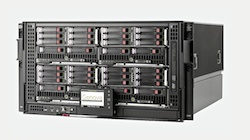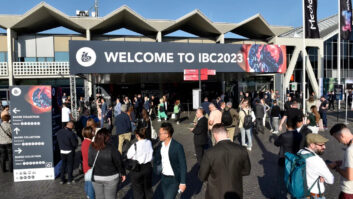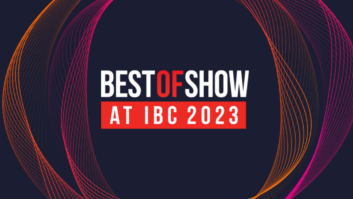
High-Efficiency Video Coding (HEVC) will be one of the hot topics at IBC. It can support HD, 4K and 8K resolutions to potentially deliver similar or better visual quality than its predecessors at half the bandwidth. Several companies will have HEVC systems on display at IBC. So here is a roundup of what they’ll be showing.
The AL1200 and AL2200 from Allegro DVT (Hall 1, Stand A46) are claimed to be “the world’s first live broadcast encoder and transcoder for HEVC” for resolutions up to HD. They support Transport Stream output and MPEG-DASH (Dynamic Adaptive Streaming over HTTP), and come with either HD-SDI or MPEG-TS inputs.
Its Genova Integrated Software Headend (pictured) is a comprehensive set of software licenses that uses off-the-shelf servers to perform transcoding and packaging for multiscreen delivery. The latest Genova HEVC/H.265 Software Encoder, which is already shipping, is interoperable with a variety of software HEVC/H.265 decoders, and is aimed at porting VoD assets (up to HD) to HEVC.
Ateme (1.D71) is showing its latest video quality/bandwidth efficiency results for both 4K Ultra HD television and for OTT profiles. It is also releasing its first HEVC product, in the form of software upgrades allowing HEVC encoding to be embedded in both Titan Live/Titan File (its carrier-grade software video transcoding system for multiscreen delivery) and Kyrion DR8400, its universal Integrated Received Decoder.
Despite both products having been introduced more than four years ago, software upgrades mean they are right up to date. Indeed, the company claims that no other professional IRD on the market can decode HEVC.
Elemental Technologies (4.B75) is demonstrating its systems for multiscreen content delivery, including full support for 4K HEVC streaming to multiple devices. Demonstrations will also include 10-bit 4K and full frame rate HEVC video processing. It will also highlight “the clear differences” between H.264 and H.265 at lower bitrates (indeed, Elemental has been able to do live encoding of HEVC at 1080p below 2.8Mbps). H.264 can only do 4×4 and 8×8 transforms, whereas H.265 is capable of multiple transforms, of up to 32×32, enabling it to devote resources to encoding the most detailed areas of the picture that are changing most (pictured – H.264 left and HEVC right).
New products from Envivio (1.D73) will include its Envivio Muse transcoding software, which can encode 4K video in HEVC. There will be a shootout comparing HEVC vs. AVC vs. MPEG-2 via realtime comparisons of the same video encoded in the three codecs, to show how HEVC can offer significant bitrate savings while preserving video quality.
“Envivio is a pioneer in advancements such as HEVC and Ultra HD encoding, and at this year’s IBC show we will feature our latest implementations of these technologies that promise to help operators improve the viewer experience while lowering operational costs,” said Julien Signès, Envivio’s president and CEO. “We believe that a software-based architecture offers the most flexibility, scalability and outstanding performance for both traditional broadcast TV services and any-screen TV.”
Ericsson (1.D61) will be talking about how HEVC can be used to enhance mobile video. Ericsson’s LTE Broadcast products combine three new standards, HEVC, eMBMS and MPEG-DASH, and are designed to address growing consumer demand for media services over 4G (LTE). Its SVP 5500 is claimed to be the world’s first HEVC encoder for mobile, capable of realtime encoding at resolutions up to HD.
Ericsson will also demonstrate support for multiscreen devices from smartphones to Connected TVs, using both MPEG-4 AVC and HEVC/MPEG-DASH, including live 4K UHDTV video contribution at 50p, 4:2:2, 10-bit resolution.
Fraunhofer Digital Cinema Alliance member Fraunhofer HHI (8.B80), which co-developed H.265/MPEG-HEVC, will show advances in encoding and decoding, including a HEVC 4K Realtime Decoder which can cope with 4K 60Hz UHD material, HEVC Realtime Software Encoder, which encodes 1080p HD video in realtime and streams it to Windows, Linux and Mac OS X clients, and a new HEVC Realtime Hardware Decoder, with ultra-low delay, which provides realtime performance for HD at 1080p30, at a clock frequency below 150MHz without an additional processor core – the design is currently implemented on an Altera (10.A10) Stratix-V FPGA.
Haivision (14.482) is previewing several advanced technology initiatives as part of its HaiGear Labs demonstrations, including, end-to-end live streaming of HEVC, using software-based encoding and decoding implementations. It will also show MPEG-DASH end-to-end live streaming and Hybrid Encoding technology, a blended approach to CPU and GPU utilisation for the encoding or transcoding processes, where a single software-based platform can get combined density gains of GPU acceleration while maintaining the quality gains of pure software on CPU. Haivision’s initial approach is to take advantage of the latest Intel CPUs, which incorporate GPUs directly as cores within the chip.
Harmonic (1.B20) is showing an Ultra HD demonstration powered by its HEVC-ready ProMedia range of multiscreen systems, featuring its new Ultra HD reference footage, which it will make available to customers for testing interoperability with HEVC clients.
There will also be a demonstration of the capabilities of its high-performance storage, with Adobe Premiere editing 4K content on a MediaGrid shared storage system.
Thomson Video Networks (14.A10) has upgraded its ViBE VS7000 encoding/transcoding platform (pictured) and its Audio/Video (A/V) Codec analyser to support HEVC. The latest ViBE VS7000 is shipping now, and the HEVC-enabled A/V Codec analyser will be available from the end of September as stand-alone software or as part of its VTS500 video test system.
At IBC, Thomson Video Networks will also demonstrate HEVC via MPEG-DASH using VisualOn’s OnStream MediaPlayer+ running HEVC decoding on Nexus tablets. OnStream MediaPlayer+ enables high-quality playback across multiple platforms, including iOS, Android, Mac OS, and Windows Desktop.
Rovi (5.A31) has a new video streaming service that it claims is the first and only available consumer software for HEVC, enabling consumers to create HEVC content for playback on 4K devices. This development is part of a significant effort by Rovi to accelerate HEVC and support its widespread adoption.
Also new is Rovi’s MainConcept encoding software development kit for professional content creators, the DivX Video Service using proven DivX DRM for protected HEVC content delivery across multiscreen devices, and an extension to its DivX Certification programme that allows integrated circuit and CE device customers to quickly bring to market mobile and consumer electronics products that support high-quality HEVC playback.
Telestream (7.C12) is launching Post Producer, a post-production and delivery engine that automates repetitive production processes that would otherwise tie up editors and NLE workstations. It is based on user templates, and assembles a segment or spot, compositing video, graphics, titles and captions or subtitles, and applying audio processing as required. Alternate versions are automatically created by simply substituting the necessary elements. It runs on the new Vantage 6 software, Telestream’s video processing platform for transcoding and file-based workflow automation, which can handle many different formats, including HEVC.
Vanguard Video (13.MS32) claims to have been first to develop a pure software commercial realtime HEVC codec. It is demonstrating a 4K H.265 codec (Main and Main10 profiles), a realtime 1080p codec, an OpenGL GPU accelerated codec, and H.265 FPGA IP cores.
The latest release of Vanguard’s V.265 realtime software encoder supports the Main10 profile, providing a 10-bit 4:2:0 codec. The Main profile outputs 8-bit 4:2:0 video, but a 10-bit profile retains more quality for 4K content. The V.265 encoder is also used by Digital Rapids (7.F33) for H.265 encoding in its Transcode Manager 2.0 automated, high-volume, file-based media processing software. V.265 will be available to Digital Rapids’ customers as a modular component integrating directly into its Kayak platform (on which Transcode Manager sits).
There will also be HEVC-related conference sessions, such as ‘High Efficiency Video Coding—Will It Do Enough?’ from 8:30-10:30am in the Emerald Room at the RAI, on Sunday, 15 September. This will be followed by ‘Beyond HD: The Technology Landscape for Future Broadcasting’ – produced in association with SMPTE, in room E102 from 11.00-12.30pm. ‘The Future of TV Viewing: Over The Top and in 4K’ (a sponsor session by Rovi), later in the day, 15:30 – 17:00, will also cover HEVC.
By David Fox
www.allegrodvt.com
www.ateme.com
www.digitalrapids.com
www.elementaltechnologies.com
www.envivio.com
www.ericsson.com/televisionary/
www.hhi.fraunhofer.de
www.haivision.com
www.harmonicinc.com
www.thomson-networks.com
www.rovicorp.com
www.telestream.net
www.vanguardvideo.com






